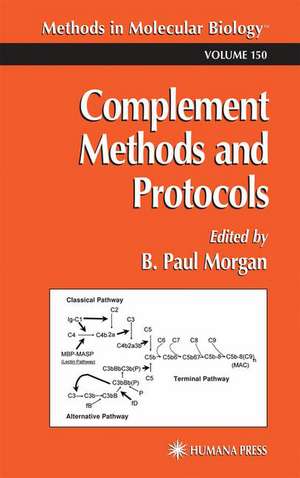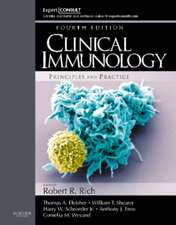Complement Methods and Protocols: Methods in Molecular Biology, cartea 150
Editat de B. Paul Morganen Limba Engleză Hardback – 30 mar 2000
| Toate formatele și edițiile | Preț | Express |
|---|---|---|
| Paperback (1) | 1094.08 lei 6-8 săpt. | |
| Humana Press Inc. – 10 noi 2010 | 1094.08 lei 6-8 săpt. | |
| Hardback (1) | 1099.73 lei 6-8 săpt. | |
| Humana Press Inc. – 30 mar 2000 | 1099.73 lei 6-8 săpt. |
Din seria Methods in Molecular Biology
- 9%
 Preț: 791.63 lei
Preț: 791.63 lei - 23%
 Preț: 598.58 lei
Preț: 598.58 lei - 20%
 Preț: 882.98 lei
Preț: 882.98 lei -
 Preț: 252.05 lei
Preț: 252.05 lei - 5%
 Preț: 802.70 lei
Preț: 802.70 lei - 5%
 Preț: 729.61 lei
Preț: 729.61 lei - 5%
 Preț: 731.43 lei
Preț: 731.43 lei - 5%
 Preț: 741.30 lei
Preț: 741.30 lei - 5%
 Preț: 747.16 lei
Preț: 747.16 lei - 15%
 Preț: 663.45 lei
Preț: 663.45 lei - 18%
 Preț: 1025.34 lei
Preț: 1025.34 lei - 5%
 Preț: 734.57 lei
Preț: 734.57 lei - 18%
 Preț: 914.20 lei
Preț: 914.20 lei - 15%
 Preț: 664.61 lei
Preț: 664.61 lei - 15%
 Preț: 654.12 lei
Preț: 654.12 lei - 18%
 Preț: 1414.74 lei
Preț: 1414.74 lei - 5%
 Preț: 742.60 lei
Preț: 742.60 lei - 20%
 Preț: 821.65 lei
Preț: 821.65 lei - 18%
 Preț: 972.30 lei
Preț: 972.30 lei - 15%
 Preț: 660.49 lei
Preț: 660.49 lei - 5%
 Preț: 738.41 lei
Preț: 738.41 lei - 18%
 Preț: 984.92 lei
Preț: 984.92 lei - 5%
 Preț: 733.29 lei
Preț: 733.29 lei -
 Preț: 392.60 lei
Preț: 392.60 lei - 5%
 Preț: 746.26 lei
Preț: 746.26 lei - 18%
 Preț: 962.66 lei
Preț: 962.66 lei - 23%
 Preț: 860.22 lei
Preț: 860.22 lei - 15%
 Preț: 652.64 lei
Preț: 652.64 lei - 5%
 Preț: 1055.50 lei
Preț: 1055.50 lei - 23%
 Preț: 883.87 lei
Preț: 883.87 lei - 19%
 Preț: 491.89 lei
Preț: 491.89 lei - 5%
 Preț: 1038.86 lei
Preț: 1038.86 lei - 5%
 Preț: 524.16 lei
Preț: 524.16 lei - 18%
 Preț: 2122.34 lei
Preț: 2122.34 lei - 5%
 Preț: 1299.23 lei
Preț: 1299.23 lei - 5%
 Preț: 1339.12 lei
Preț: 1339.12 lei - 18%
 Preț: 1390.26 lei
Preț: 1390.26 lei - 18%
 Preț: 1395.63 lei
Preț: 1395.63 lei - 18%
 Preț: 1129.65 lei
Preț: 1129.65 lei - 18%
 Preț: 1408.26 lei
Preț: 1408.26 lei - 18%
 Preț: 1124.92 lei
Preț: 1124.92 lei - 18%
 Preț: 966.27 lei
Preț: 966.27 lei - 5%
 Preț: 1299.99 lei
Preț: 1299.99 lei - 5%
 Preț: 1108.51 lei
Preț: 1108.51 lei - 5%
 Preț: 983.76 lei
Preț: 983.76 lei - 5%
 Preț: 728.16 lei
Preț: 728.16 lei - 18%
 Preț: 1118.62 lei
Preț: 1118.62 lei - 18%
 Preț: 955.25 lei
Preț: 955.25 lei - 5%
 Preț: 1035.62 lei
Preț: 1035.62 lei - 18%
 Preț: 1400.35 lei
Preț: 1400.35 lei
Preț: 1099.73 lei
Preț vechi: 1157.60 lei
-5% Nou
Puncte Express: 1650
Preț estimativ în valută:
210.42€ • 219.72$ • 173.77£
210.42€ • 219.72$ • 173.77£
Carte tipărită la comandă
Livrare economică 16-30 aprilie
Preluare comenzi: 021 569.72.76
Specificații
ISBN-13: 9780896036543
ISBN-10: 0896036545
Pagini: 259
Ilustrații: IX, 259 p.
Dimensiuni: 152 x 229 x 16 mm
Greutate: 0.55 kg
Ediția:2000
Editura: Humana Press Inc.
Colecția Humana
Seria Methods in Molecular Biology
Locul publicării:Totowa, NJ, United States
ISBN-10: 0896036545
Pagini: 259
Ilustrații: IX, 259 p.
Dimensiuni: 152 x 229 x 16 mm
Greutate: 0.55 kg
Ediția:2000
Editura: Humana Press Inc.
Colecția Humana
Seria Methods in Molecular Biology
Locul publicării:Totowa, NJ, United States
Public țintă
Professional/practitionerCuprins
The Complement System:An Overview.- Purification of Complement Components, Regulators, and Receptors by Classical Methods.- Immunoaffinity Methods for Purification of Complement Components and Regulators.- Measurement of Complement Hemolytic Activity, Generation of Complement-Depleted Sera, and Production of Hemolytic Intermediates.- Measurement of Complement Lysis of Nucleated Cells.- Functional Assays for Complement Regulators.- Immunochemical Measurement of Complement Components and Activation Products.- Complement Deposition in Tissues.- Complement Regulators and Receptors in Tissues.- Measurement of C3 Fragment Deposition on Cells.- Screening for Complement Deficiency.- C1-Inhibitor: Antigenic and Functional Analysis.- Autoantibodies to Complement Components.- Allotyping of Complement Components.- Complement and Immune Complexes.- Knocking Out Complement Genes.- Inherited Complement Deficiencies in Animals.
Recenzii
recommended for inclusion in biomedical research libraries, both corporate and academic." - E-Streams
Textul de pe ultima copertă
Although the complement system-a vital part of the body's defense against bacteria-was discovered more than a century ago, its study has undergone a renaissance with the identification of its regulatory molecules and the realization that these molecules can be used therapeutically. In Complement Methods and Protocols, B. Paul Morgan and a team of expert laboratorians present a comprehensive set of readily reproducible methods to study this critical system. These cutting-edge techniques are suitable both for the basic scientist interested in understanding complement's mechanisms of activation and for the clinical scientist wishing to quantify its activation, and range from the purification of its components to generating complement-deficient mice by gene deletion. Additional techniques presented include procedures for the analysis of complement function, for the study of its regulators, for detection of its activation in vivo, and for the identification of its autoantibodies.
Comprehensive and cutting-edge, Complement Methods and Protocols offers today's basic and clinical investigators powerful tools for the analysis of the role of complement in human pathophysiology and disease, as well as its therapeutic regulation.
Comprehensive and cutting-edge, Complement Methods and Protocols offers today's basic and clinical investigators powerful tools for the analysis of the role of complement in human pathophysiology and disease, as well as its therapeutic regulation.
Caracteristici
Includes supplementary material: sn.pub/extras






